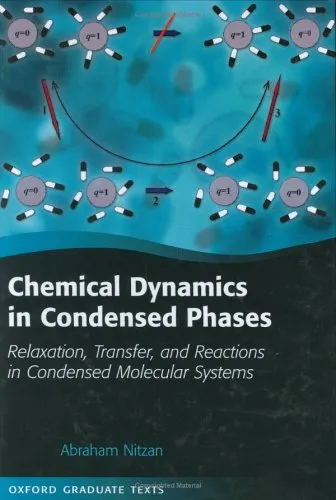Chemical Dynamics in Condensed Phases: Relaxation, Transfer, and Reactions in Condensed Molecular Systems
4.7
Reviews from our users

You Can Ask your questions from this book's AI after Login
Each download or ask from book AI costs 2 points. To earn more free points, please visit the Points Guide Page and complete some valuable actions.Introduction to "Chemical Dynamics in Condensed Phases"
"Chemical Dynamics in Condensed Phases: Relaxation, Transfer, and Reactions in Condensed Molecular Systems," authored by Abraham Nitzan, offers a comprehensive exploration of chemical dynamics within environments where molecules interact strongly, such as liquids, solids, and complex biological systems. This book serves as a vital bridge between theoretical chemistry, molecular physics, and material sciences, providing a detailed understanding of how microscopic molecular interactions give rise to macroscopic phenomena.
The condensed phase presents unique and fascinating challenges to chemists and physicists because the behavior of an individual molecule is strongly influenced by its surroundings. This book delves into the intricate mechanisms of relaxation, energy transfer, and chemical reactivity in these environments, focusing on both theoretical frameworks and experimental techniques. Catering to graduate students, researchers, and seasoned professionals, it offers readers a robust foundation for analyzing chemical phenomena in complex systems.
Detailed Summary
The book is structured around key concepts that govern chemical processes in condensed phases. It begins with an overview of the theoretical tools necessary for understanding molecular interactions within these dense environments. Statistical mechanics, quantum mechanics, and kinetic theories are extensively reviewed to establish a solid analytical foundation.
The heart of the book explores dynamics in the condensed phase through the study of relaxation processes. These include vibrational, rotational, and electronic energy relaxation, which govern how systems return to equilibrium after perturbation. Special focus is given to the role of solvent dynamics, friction, and many-body interactions in shaping these relaxation processes.
A key section discusses energy and charge transfer mechanisms, including Förster resonance energy transfer (FRET) and charge hopping models. These processes play an essential role in molecular electronics, photosynthesis, and organic photovoltaics, showcasing their relevance in both biological systems and human-engineered materials.
The book concludes with a detailed examination of chemical reactions in condensed phases, from simple bimolecular reactions to complex reactions in biological systems. The interplay between reactants, solvents, and thermal fluctuations is analyzed, marrying theory with practical experimental insights.
Each chapter provides extensive references to foundational studies and modern advancements, helping readers deepen their understanding while exploring specific areas of interest.
Key Takeaways
- An in-depth theoretical foundation, focusing on quantum mechanics, statistical mechanics, and kinetic models.
- Comprehensive coverage of relaxation dynamics, including vibrational, rotational, and electronic processes.
- Insightful analysis of energy and charge transfer phenomena, with real-world applications such as photosynthesis and organic electronics.
- A detailed discussion of the mechanisms of chemical reactions in dense environments and complex systems.
- A balanced treatment of theory and experimentation, making the book accessible to both theorists and experimentalists.
Famous Quotes from the Book
"The behavior of molecules in condensed systems defies simplistic interpretations; it demands a nuanced understanding where theory and experiment coexist harmoniously."
"Chemical dynamics in condensed phases are the interplay of chaos and order, where an individual molecule's future is written in the dance of its neighbors."
Why This Book Matters
This book occupies a unique niche in the scientific literature by offering a well-rounded treatment of chemical dynamics in condensed phases. It is of immense value to those seeking to understand the complexities of molecular systems where interactions, noise, and environmental effects play a central role. From molecular biologists studying enzyme reactions to material scientists exploring organic semiconductors, the insights in this book span across disciplines. It not only elucidates theoretical principles but also provides practical guidance for interpreting experimental data. In doing so, it serves as both a reference and a source of inspiration for advancing research across diverse fields.
Whether one is a student eager to grasp the inner workings of molecular dynamics or a seasoned researcher delving into the world's complex molecular environments, this book offers the tools, knowledge, and perspective necessary to navigate the intricate, interconnected world of condensed-phase chemistry.
Free Direct Download
You Can Download this book after Login
Accessing books through legal platforms and public libraries not only supports the rights of authors and publishers but also contributes to the sustainability of reading culture. Before downloading, please take a moment to consider these options.
Find this book on other platforms:
WorldCat helps you find books in libraries worldwide.
See ratings, reviews, and discussions on Goodreads.
Find and buy rare or used books on AbeBooks.


